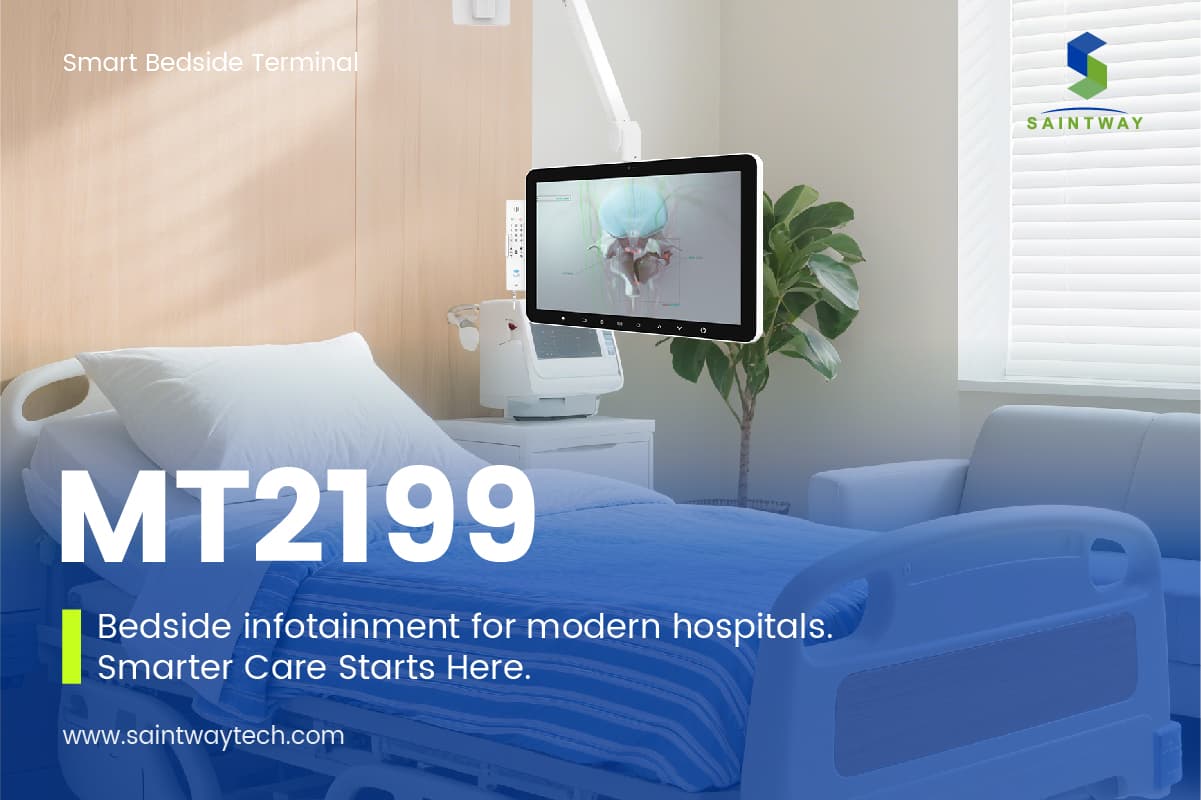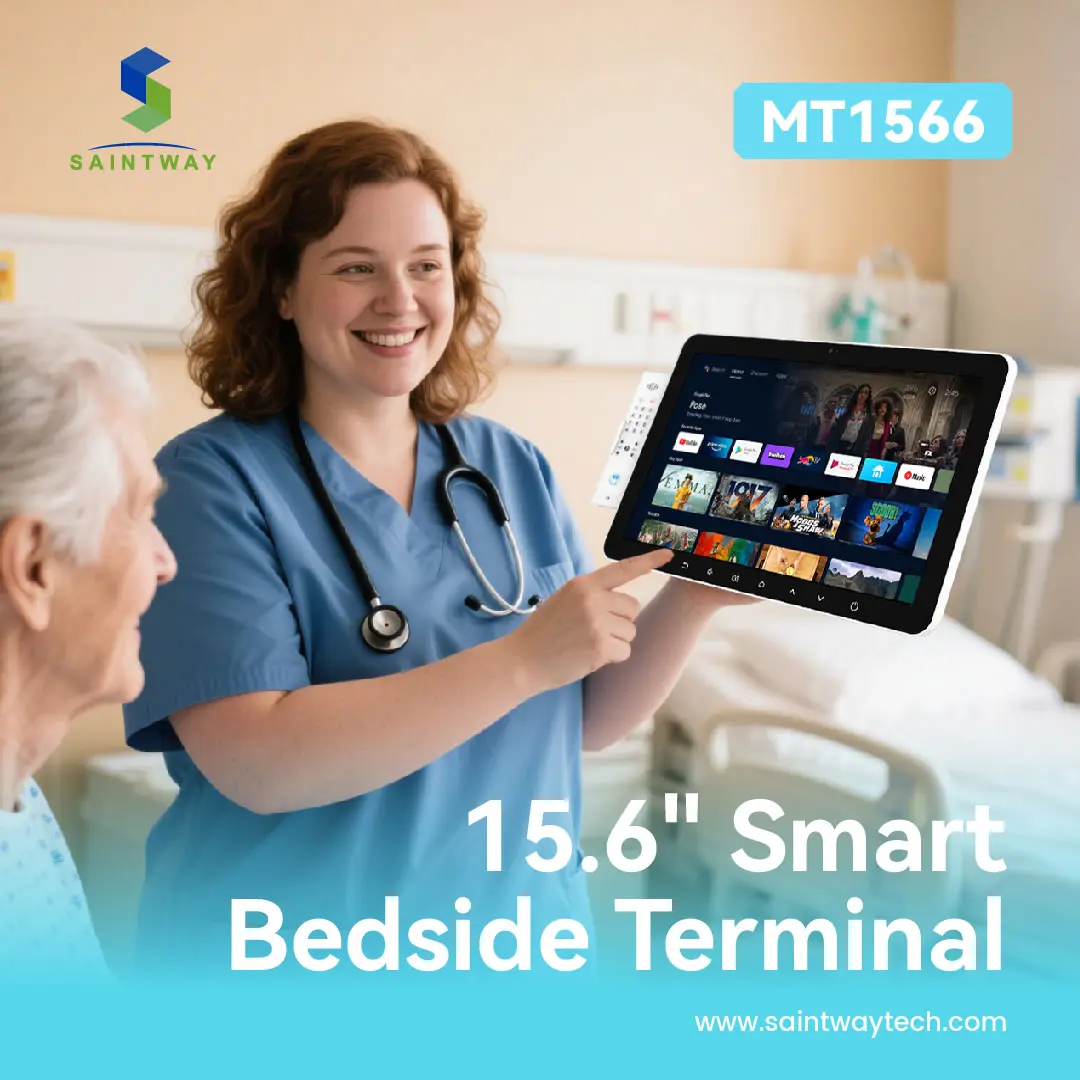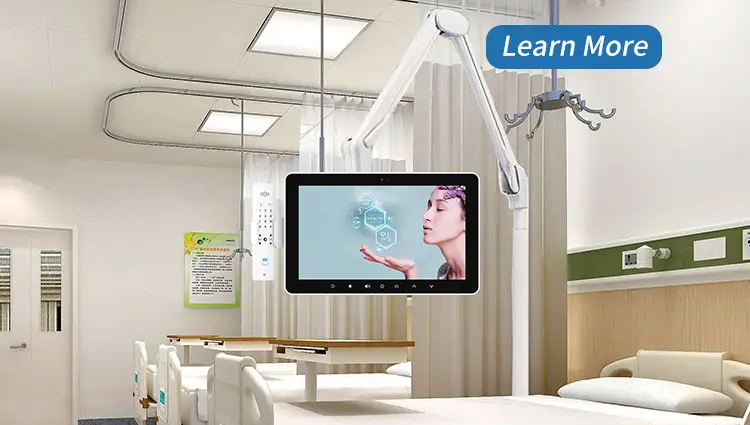Let’s face it: hospital stays can be tough. The sterile environment, the unfamiliar routines, and the often-overwhelming sense of isolation can make recovery feel like an uphill battle. But what if there was a way to transform that experience, to bring comfort, connection, and even a little bit of joy directly to the patient’s fingertips? This is where bedside infotainment steps in, ushering in a new era of patient-centered care.

From Boredom to Engagement: The Power of the Patient Infotainment Terminal
Imagine being confined to a hospital bed, staring at the ceiling, and feeling disconnected from the outside world. Now, picture this: you tap a screen beside your bed, and suddenly, you have access to movies, your favorite music, video calls with family, educational resources about your condition, and even the ability to order meals or adjust your room’s temperature. That’s the magic of a patient infotainment terminal. It’s not just a fancy gadget; it’s a lifeline, a bridge to a more comfortable and engaging recovery.
What’s Under the Hood? Features of a Modern Bedside Infotainment Terminal
These isn’t just a basic TV. Modern bedside infotainment terminals are powerful, purpose-built devices designed to meet the unique needs of a healthcare environment. Let’s break down some of their key features:
- Touchscreen Interface: Most terminals, whether a 15.6″ Patient Infotainment unit or a larger 21.5″ Patient Infotainment display, come with intuitive touchscreens. This makes them super easy to use, even for patients who aren’t tech-savvy. Think of it like using your smartphone, but specifically designed for a hospital setting.
- High-Definition Displays: Clarity matters, especially when you’re watching a movie or video calling loved ones. These terminals boast crisp, vibrant displays that make everything look great.
- Integrated Cameras and Microphones: Many units include built-in cameras and microphones, enabling seamless video calls with family and friends, reducing the feeling of isolation. It’s like having your own personal communication hub right there.
- Robust and Easy-to-Clean Design: Hospitals are all about hygiene. So, these terminals are built tough, often with antimicrobial surfaces, to withstand rigorous cleaning protocols and prevent the spread of germs. They’re designed to be as safe as they are smart.
- Connectivity Options: From Wi-Fi to Ethernet, these terminals are always connected, ensuring reliable access to the internet and hospital networks. This means your movies won’t buffer and your video calls won’t drop.
- Customizable Software: Hospitals can tailor the software to their specific needs, offering a personalized experience for each patient. This means they can choose what apps and services are available, from entertainment to educational content.
- Integration with Hospital Systems: This is a big one. These terminals aren’t just standalone devices. They can connect directly with the hospital’s electronic health records (EHR) system, allowing patients to view their medical information, lab results, and even medication schedules. It’s a huge step towards empowering patients with more control over their healthcare journey.
- Privacy Features: Patient privacy is paramount. These terminals are designed with strong security measures to protect sensitive patient data, ensuring that personal information remains confidential.

Why Hospitals Love Them: Advantages of Healthcare Infotainment All In One Computer (Bedside)
The benefits of implementing a Healthcare Infotainment All In One Computer extend far beyond just patient comfort. Hospitals are seeing tangible advantages, making these systems a smart investment:
- Improved Patient Satisfaction Scores: Happy patients often lead to better outcomes. By offering entertainment, communication, and education, hospitals can significantly boost their patient satisfaction ratings. It’s a direct way to show patients they care about their overall well-being, not just their medical treatment.
- Enhanced Communication: These terminals facilitate better communication between patients and their care team. Patients can send messages to nurses, request assistance, or even provide feedback directly through the device, streamlining workflows and reducing the need for constant verbal requests.
- Streamlined Operations: With features like meal ordering and facility information readily available, staff spend less time answering routine questions, freeing them up to focus on direct patient care. This means nurses can spend more time doing what they do best: caring for patients, rather than running errands.
- Reduced Patient Anxiety and Boredom: A distracted patient is often a less anxious patient. Providing engaging content can help patients cope with the stress of hospitalization and alleviate boredom during long recovery periods. Think of it as a much-needed mental break during a challenging time.
- Empowered Patients through Education: Patients can access a wealth of information about their condition, treatment plans, and discharge instructions, leading to greater understanding and adherence to medical advice. When patients are informed, they feel more in control and are more likely to follow their care plan.
- Potential for Revenue Generation: Some hospitals explore partnerships to offer premium content or services through the terminals, creating new revenue streams. This can help offset the initial investment in the technology.
- Competitive Edge: In an increasingly competitive healthcare landscape, offering state-of-the-art patient infotainment solutions can differentiate a hospital and attract more patients. It signals a commitment to innovation and patient-centered care.
The Big Picture: Benefits for Everyone with Smart Terminals
For patients, the benefits are immediate and profound:
- Comfort and Control: Imagine having your entertainment, communication, and even environmental controls right at your fingertips. No more waiting for a nurse to adjust the thermostat or bring a magazine. This gives patients a sense of agency and comfort during a time when they often feel helpless. It’s about making a hospital room feel a little more like home.
- Faster Recovery (Potentially): While hard to quantify directly, a more relaxed, engaged, and informed patient is generally in a better mental state, which can contribute to a smoother and potentially quicker recovery. When your mind is at ease, your body can focus on healing.
- Stronger Connections: The ability to easily video call family and friends, share updates, and receive virtual visits is a game-changer. It helps maintain crucial social connections, reducing feelings of loneliness and isolation that can often accompany a hospital stay. This is particularly vital for long-term patients.
For healthcare providers (nurses, doctors, and staff):
- More Efficient Workflows: By reducing routine requests and empowering patients to self-serve for certain needs, staff can dedicate more time to critical medical tasks and direct patient care. This means less running around for minor requests and more focus on complex patient needs.
- Improved Communication and Education Delivery: Delivering consistent, high-quality patient education becomes easier and more effective. Nurses can ensure patients have access to the right information at the right time, leading to better understanding and adherence to care plans.
- Reduced Stress and Burnout: When routine tasks are streamlined and patients are more engaged, it can lead to a less stressful work environment for healthcare professionals. This helps prevent burnout and keeps staff happier and more effective.
For hospitals and healthcare systems:
- Enhanced Reputation and Patient Loyalty: Hospitals that invest in a superior patient experience, often spearheaded by advanced bedside infotainment, build a reputation for quality and innovation. This attracts new patients and fosters loyalty among existing ones. It signals that the hospital is forward-thinking and prioritizes patient well-being.
- Data-Driven Insights: These terminals can collect valuable data on patient engagement with educational content, entertainment choices, and even feedback. This data can then be used to further refine services and improve the overall patient experience. It’s about learning and continuously improving.
- Future-Proofing: As technology advances and patient expectations evolve, integrating smart terminals ensures that healthcare facilities remain at the forefront of patient care innovation. It’s an investment in the future of healthcare.
The Future is Now: Embracing Patient Infotainment Bedside Terminal Technology
The days of simply “treating” patients are evolving. Modern healthcare is about caring for the whole person, and that includes their comfort, mental well-being, and ability to stay connected. The patient infotainment bedside terminal is more than just a convenience; it’s a vital tool in achieving these goals. From the compact 15.6″ Patient Infotainment screens to the expansive 21.5″ Patient Infotainment displays, these devices are transforming the patient journey, one tap at a time.
As we move forward, expect to see even more sophisticated features, deeper integration with personal devices, and an even greater focus on personalized content. The ultimate goal is to make every hospital stay as comfortable, informative, and empowering as possible. It’s an exciting time for healthcare, and bedside infotainment is leading the charge!
What do you think is the most important feature a bedside infotainment system should have for patients?
Upgrade your healthcare experience today! Curious to see the difference? Click to request a demo:https://www.saintwaytech.com/contact-us/

